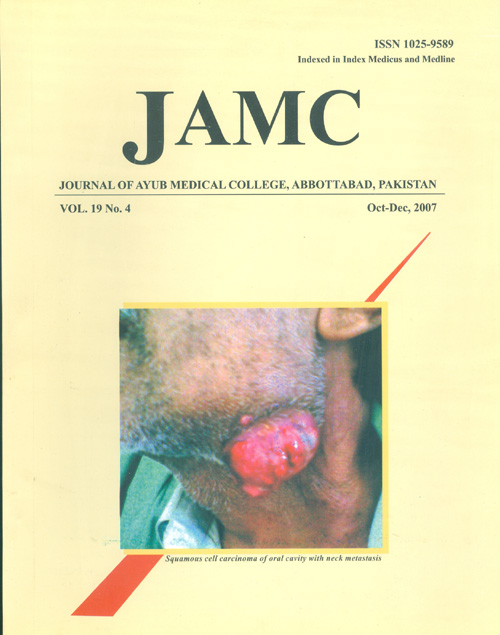EVALUATION OF SAFETY OF BIPOLAR DIATHERMY TONSILLECTOMY
Abstract
Background: Tonsillectomy is a common operation in both children as well as adults, performedby a variety of techniques that have evolved over the years to ensure the safety of the procedure.
Cold dissection and electrodissection are the two mostly used techniques. Bipolar diathermy
tonsillectomy was evaluated for its safety and postoperative morbidity. Methods: This study was
conducted over a period of two years, in the Department of Ear, Nose Throat and Head & Neck
Surgery at Ayub Teaching Hospital, Abbottabad, Pakistan. Two hundred and forty-six were
enrolled; however, 238 patients completed the full evaluation as the technique had to be modified
in 8 patients. All the procedures were performed by the first author thereby ensuring the same
expertise level. Operating time, intraoperative blood loss, postoperative algesia, feeding status and
time taken getting back to school/work and episodes of secondary bleeding were recorded.
Results: Time taken by the procedure ranged from 10 to 20 minutes. Intraoperative blood loss
ranged between 2 to 5 ml. Postoperative pain averaged around 3-5 on a 1-10 point scale in 75%
of patients. 80% of patients were back to normal diet by day 3 postoperative. Nine (3.6%) patients
had a secondary haemorrhage that was managed conservatively and did not need surgical
intervention. Conclusion: Bipolar diathermy tonsillectomy is an effective and safe technique,
especially in children population. Adequate experience with the technique is mandatory to achieve
the desired goals.
Keywords: Tonsillectomy; Electro dissection; Bipolar diathermy; Morbidity
References
Pang YT. Paediatric tonsillectomy: bipolar electrodissection
and dissection/snare compared. J Laryngol Otol.
;109(8):733-6.
Burton MJ, Doree C. Coblation versus other surgical
techniques for tonsillectomy. Cochrane Database Syst Rev.
;(3):CD004619. Comment in: Otolaryngol Head Neck
Surg. 2008;138(1):4-7.
Gendy S, O'Leary M, Colreavy M, Rowley H, O'Dwyer T,
Blayney A. Tonsillectomy--cold dissection vs. hot dissection:
a prospective study. Ir Med J. 2005;98(10):243-4.
Sargi Z, Younis RT. Tonsillectomy and adenoidectomy
techniques: past, present and future. ORL J Otorhinolaryngol
Relat 2007;69(6):331-5.
Bukhari MA, Al-Ammar AY. Monopolar electrodissection
versus cold dissection tonsillectomy among children. Saudi
Med J. 2007;28(10):1525-8.
Silveira H, Soares JS, Lima HA. Tonsillectomy: cold
dissection versus bipolar electrodissection. Int J Pediatr
Otorhinolaryngol. 2003;67(4):345-51.
Atallah N, Kumar M, Hilali A, Hickey S. Post-operative pain
in tonsillectomy: bipolar electrodissection technique vs
dissection ligation technique. A double-blind randomized
prospective trial.J Laryngol Otol. 2000;114(9):667-70.
Kirazli T, Bilgen C, Midilli R, Ogüt F, Uyar M, Kedek A.
Bipolar electrodissection tonsillectomy in children. Eur Arch
Otorhinolaryngol. 2005;262(9):716-8.
Cardozo AA, Hallikeri C, Lawrence H, Sankar V, Hargreaves
S. Teenage and adult tonsillectomy: dose-response relationship
between diathermy energy used and morbidity. Clin
Otolaryngol. 2007;32(5):366-71.
Shah SA, Ghani R. Frequency of post-tonsillectomy
haemorrhage following tonsillectomy with bipolar
diathermy--an experience at Ayub Teaching Hospital,
Abbottabad. J Ayub Med Coll Abbottabad. 2004;16(4):38-9.
Lowe D, van der Meulen J, Cromwell D, Lewsey J, Copley
L, Browne J, et al. Key messages from the National
Prospective Tonsillectomy Audit. Laryngoscope.
;117(4):717-24.
Downloads
How to Cite
Issue
Section
License
Journal of Ayub Medical College, Abbottabad is an OPEN ACCESS JOURNAL which means that all content is FREELY available without charge to all users whether registered with the journal or not. The work published by J Ayub Med Coll Abbottabad is licensed and distributed under the creative commons License CC BY ND Attribution-NoDerivs. Material printed in this journal is OPEN to access, and are FREE for use in academic and research work with proper citation. J Ayub Med Coll Abbottabad accepts only original material for publication with the understanding that except for abstracts, no part of the data has been published or will be submitted for publication elsewhere before appearing in J Ayub Med Coll Abbottabad. The Editorial Board of J Ayub Med Coll Abbottabad makes every effort to ensure the accuracy and authenticity of material printed in J Ayub Med Coll Abbottabad. However, conclusions and statements expressed are views of the authors and do not reflect the opinion/policy of J Ayub Med Coll Abbottabad or the Editorial Board.
USERS are allowed to read, download, copy, distribute, print, search, or link to the full texts of the articles, or use them for any other lawful purpose, without asking prior permission from the publisher or the author. This is in accordance with the BOAI definition of open access.
AUTHORS retain the rights of free downloading/unlimited e-print of full text and sharing/disseminating the article without any restriction, by any means including twitter, scholarly collaboration networks such as ResearchGate, Academia.eu, and social media sites such as Twitter, LinkedIn, Google Scholar and any other professional or academic networking site.










